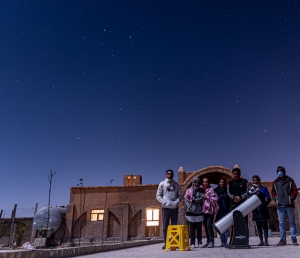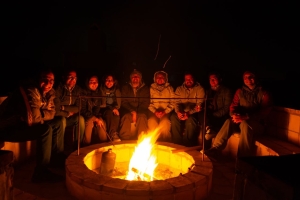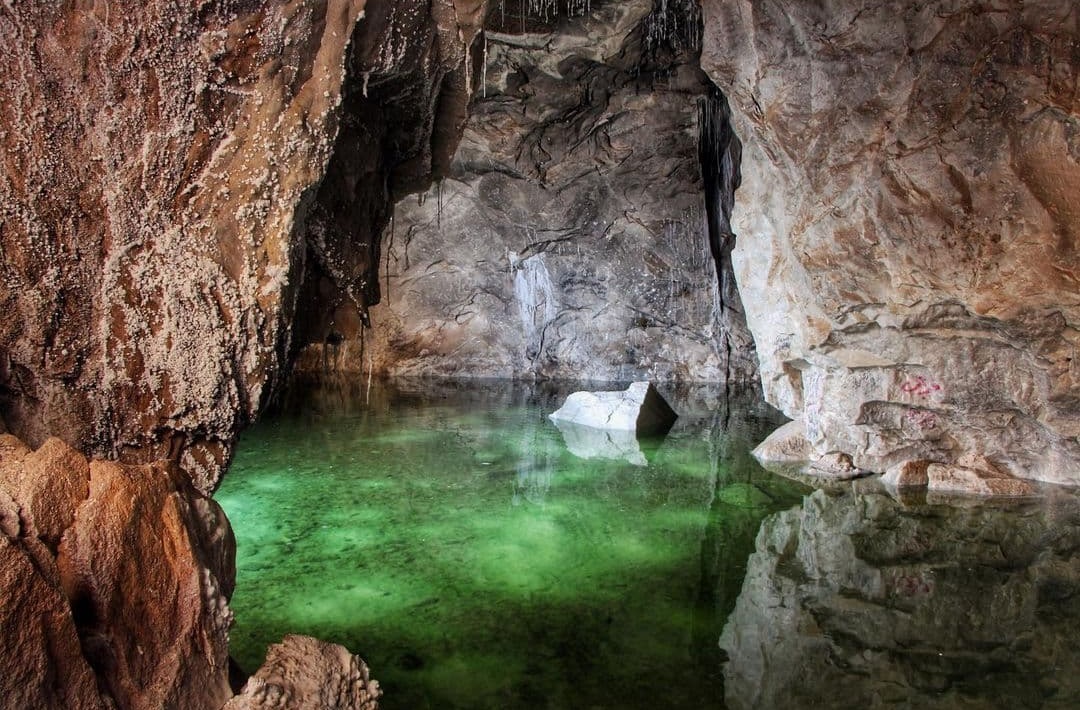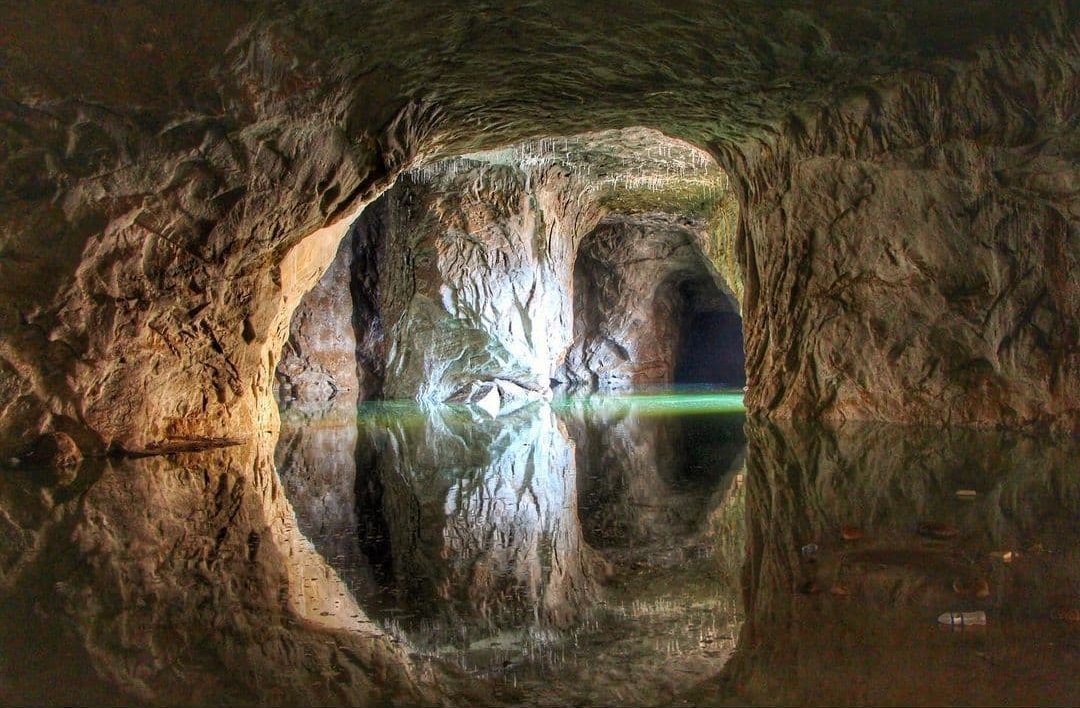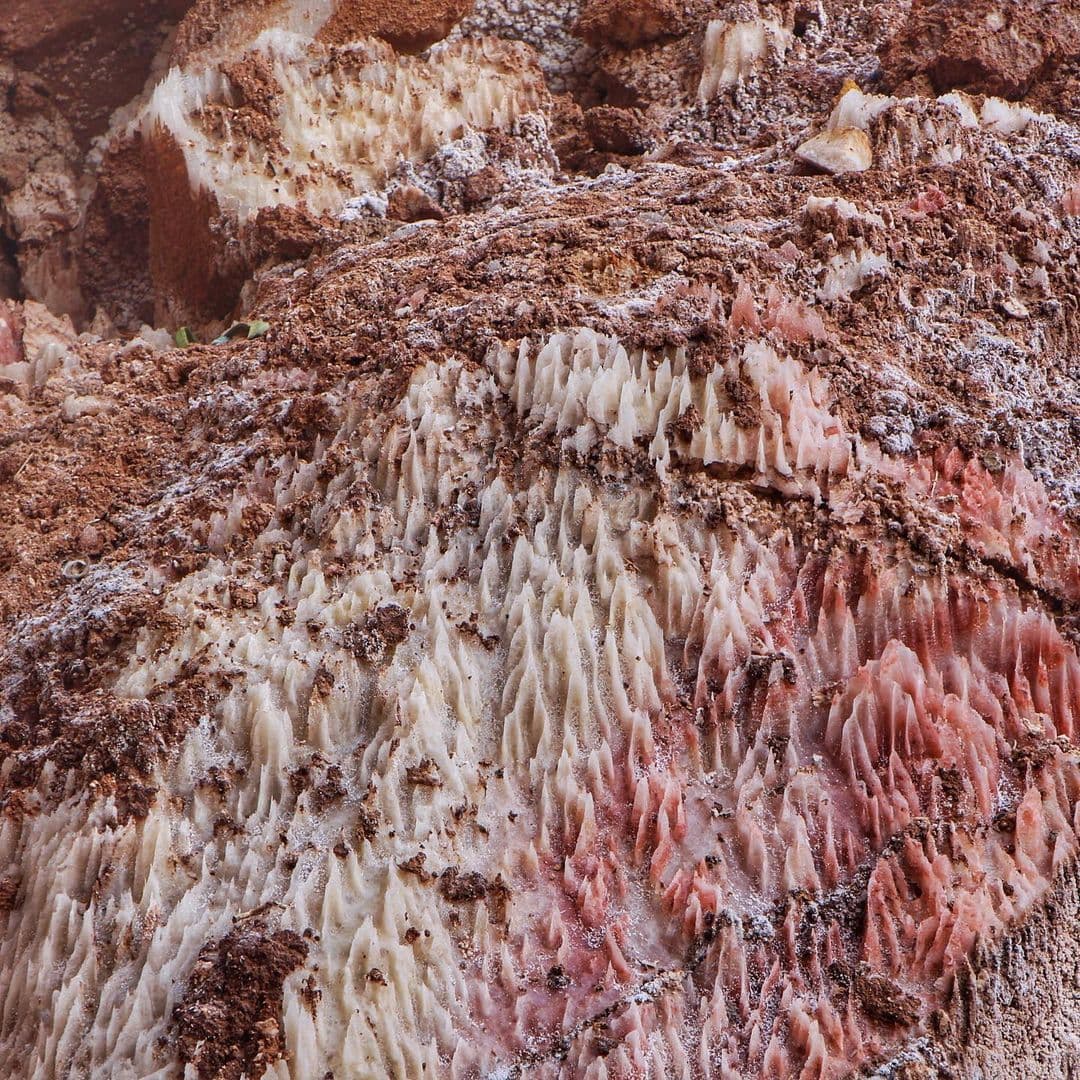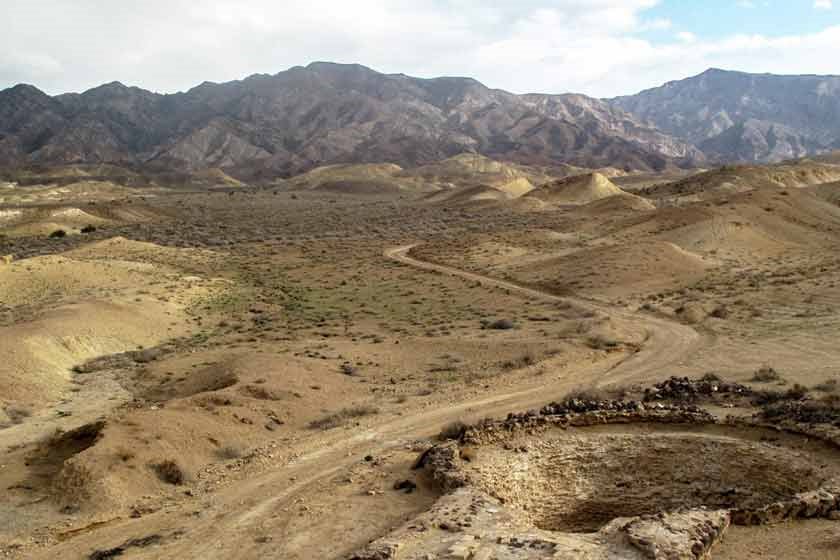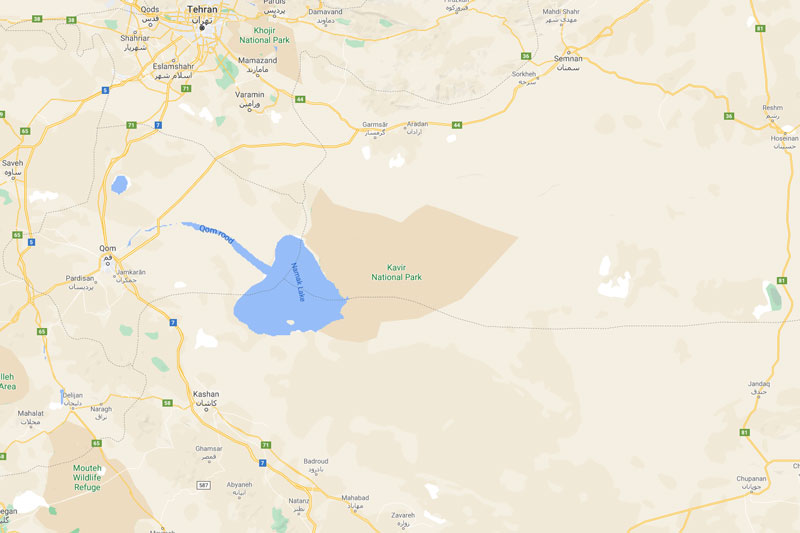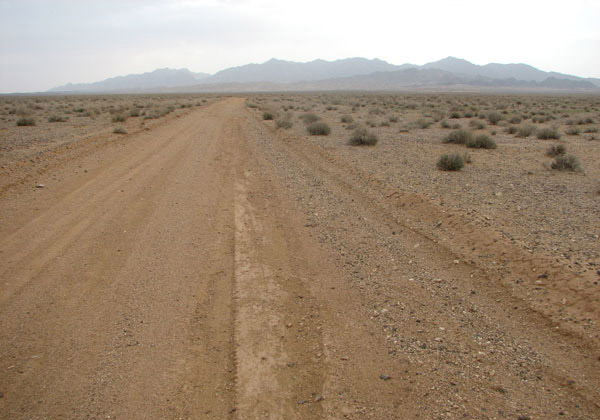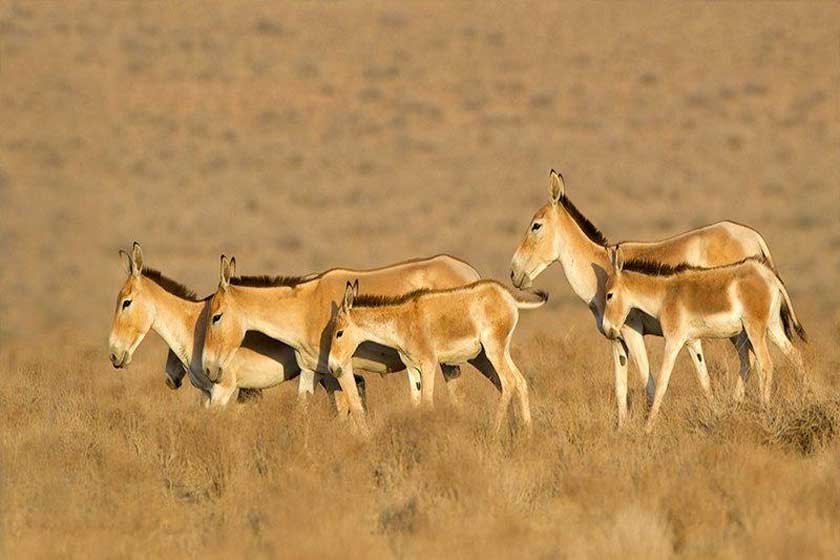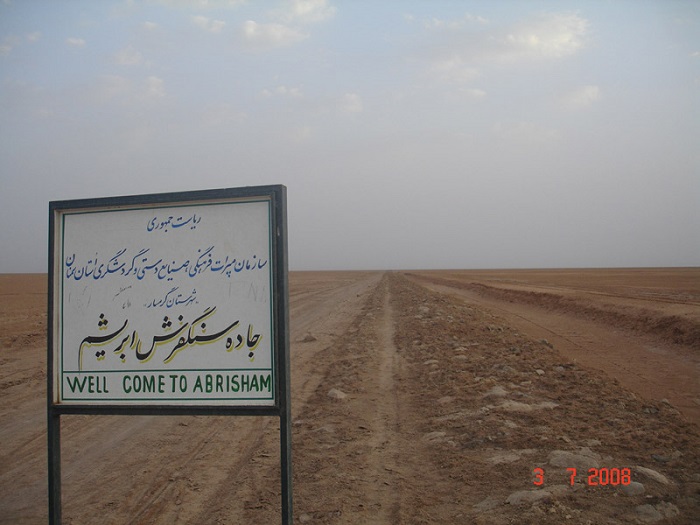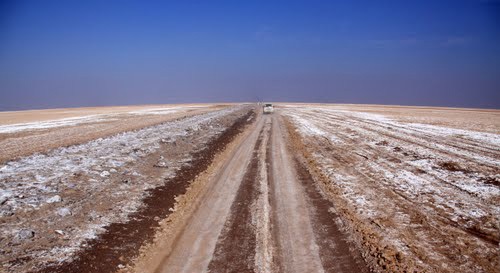ШӘШ§ШұЫҢШ®ЪҶЩҮ Ъ©Ш§ШұЩҲШ§ЩҶШіШұШ§ЫҢ ЩӮШөШұ ШЁЩҮШұШ§Щ…
ШҜШұ Ш§ЩҲШ§ЫҢЩ„ ШіШ§Щ„ ЫұЫіЫіЫ· Щ…Ш·Щ„ШЁЫҢ ШҜШұ ШұЩҲШІЩҶШ§Щ…ЩҮвҖҢЩҮШ§ЫҢ Ш§ЫҢШұШ§ЩҶ ШӘШӯШӘ Ш№ЩҶЩҲШ§ЩҶ Ъ©ШҙЩҒ ЩӮШөШұ ШЁЩҮШұШ§Щ… ЪҜЩҲШұ ШҜШұ ЩҶШІШҜЫҢЪ©ЫҢ ШҜШұЫҢШ§ЪҶЩҮвҖҢЫҢ ЩҶЩ…Ъ© Ъ©ЩҲЫҢШұ Щ…ШұЪ©ШІЫҢ Щ…ЩҶШӘШҙШұ ШҙШҜ.
Ш§ЩҶШӘШҙШ§Шұ Ш§ЫҢЩҶ Ш®ШЁШұ ШЁЩҮ Щ…Ш§ЩҶЩҶШҜ Ъ©ШҙЩҒ ШЁЩҶШ§ЫҢЫҢ ЩҶШ§ШҙЩҶШ§Ш®ШӘЩҮ ЩҲ ЩҫЫҢШҜШ§ ШҙШҜЩҶ ШЁЩҶШ§ЫҢЫҢ ШҜЫҢЪҜШұ Ш§ШІ ШіШ§ШіШ§ЩҶЫҢШ§ЩҶ ШЁШ§ШІШӘШ§ШЁ ЫҢШ§ЩҒШӘ. Ш§Щ…Ш§ ШұШ§ШіШӘШҙ ШЁЩҶШ§В ШӘШ§ ШўЩҶвҖҢ Щ…ЩҲЩӮШ№ Ш®ЫҢЩ„ЫҢ
ЩҶШ§ШҙЩҶШ§Ш®ШӘЩҮ ЩҶШЁЩҲШҜ ЩҲВ ШӘШ№Щ„ЩӮ ШўЩҶ ШЁЩҮ ШҜЩҲШұЩҮвҖҢЫҢ ШіШ§ШіШ§ЩҶЫҢ ЩҶЫҢШІ ЩӮШ·Ш№ЫҢ ШЁЩҮ ЩҶШёШұ ЩҶЩ…ЫҢвҖҢШұШіЫҢШҜ. Ш§ЪҜШұ Ш§ШІ ЩҮЩ…Ш§ЩҶ ШіШ§Щ„ ЫұЫіЫіЫ· ШЁЩҮ Ш№ЩӮШЁ ШЁШұЩҲЫҢЩ…ШҢ Ш®ЩҲШ§ЩҮЫҢЩ… ШҜЫҢШҜ Ъ©ЩҮ
Ш§ЫҢШұШ§ЩҶвҖҢвҖҢШҙЩҶШ§ШіШ§ЩҶ ШЁШұШ¬ШіШӘЩҮ ШЁЩҮ ШўЩҶ ШӘЩҲШ¬ЩҮ ЩҶШҙШ§ЩҶ ШҜШ§ШҜЩҮвҖҢШ§ЩҶШҜ. Щ…ШұШӯЩҲЩ… Щ…ЩҶЩҲЪҶЩҮШұ ШіШӘЩҲШҜЩҮ (ЫұЫІЫ№ЫІ вҖ“ ЫұЫіЫ№Ыө) ШўЩҶЪҶЩҶШ§ЩҶ ШЁЩҮ Щ…ЩҶШ·ЩӮЩҮ Ш§ШҙШұШ§ЩҒ ШҜШ§ШҙШӘ Ъ©ЩҮ ШұШ§ЩҮЩҶЩ…Ш§ЫҢ
Ш№Щ„Ш§ЩӮЩҮвҖҢЩ…ЩҶШҜШ§ЩҶ Щ…ЫҢвҖҢШҙШҜ. Щ…ШұШӯЩҲЩ… Ш§ЫҢШұШ¬ Ш§ЩҒШҙШ§Шұ (ЫұЫіЫ°Ыҙ – ЫұЫіЫёЫ№) ЩҶЫҢШІ ШҜШұ ШіШ§Щ„ ЫұЫіЫіЫҙ Ш§ШІ Ш§ЫҢЩҶ ШЁЩҶШ§ Ш№Ъ©ШівҖҢЩҮШ§ЫҢЫҢ ШЁШұШҜШ§ШҙШӘЩҮ ШЁЩҲШҜ. ШҜШұ ШіШ§Щ„ ЫұЫіЫұЫІ
ШўЩ„ЩҒЩҲЩҶШі ЪҜШ§ШЁШұЫҢЩ„ (Alfons Gabriel) Ш§ШӘШұЫҢШҙЫҢ ШЁЩҮ ЩҮЩ…ШұШ§ЩҮ ЩҮЩ…ШіШұШҙ Ш§ШІ ШўЩҶ ШҜЫҢШҜЩҶ Ъ©ШұШҜЩҮ ШЁЩҲШҜ. ШЁЩҲЩҮШІЩҮвҖҢ (F. A. Buhse)ШҢ ЪҜЫҢШ§ЩҮвҖҢШҙЩҶШ§Ші ШұЩҲШіЫҢШҢ
ШҜШұ ШіШ§Щ„ ЫұЫёЫҙЫ№ (ЫұЫІЫІЫё Ш®ЩҲШұШҙЫҢШҜЫҢ) Ш§ШІ ШўЩҶ Ш№ШЁЩҲШұ Ъ©ШұШҜ. ШӯШӘЫҢ Ш§ЫҢЩҶ Ъ©Ш§ШұЩҲШ§ЩҶШіШұШ§ ШҜШұ ЪҜШІШ§ШұШҙ ЩҫЫҢШӘШұЩҲ ШҜЩ„Ш§ЩҲШ§Щ„ЩҮ (Pietro della Valle) ЩҲ ШӘЩҲЩ…Ш§Ші ЩҮШұШЁШұШӘ
(Thomas Herbert)ШҢ Ъ©ЩҮ ЩҮШұ ШҜЩҲ ШҜШұ ЩӮШұЩҶ ЩҮЩҒШҜЩҮЩ… Щ…ЫҢЩ„Ш§ШҜЫҢ Щ…ЫҢвҖҢШІЫҢШіШӘЩҶШҜШҢ ШўЩ…ШҜЩҮ Ш§ШіШӘ. Ъ©Ш§ШұЩҲШ§ЩҶШіШұШ§ЫҢ ЩӮШөШұ ШЁЩҮШұШ§Щ… Ъ©ЩҮ ШЁШ§ ЩҶШ§Щ…вҖҢЩҮШ§ЫҢ Ъ©Ш§ШұЩҲШ§ЩҶШіШұШ§ЫҢ
ШҙШ§ЩҮ Ш№ШЁШ§ШіЫҢ ЩҲ ШұШЁШ§Ш· ШіЫҢШ§ЩҮвҖҢЪ©ЩҲЩҮ ЩҶЫҢШІ ШҙЩҶШ§Ш®ШӘЩҮ ШҙШҜЩҮ Ш§ШіШӘШҢ Ш§ШІ Ш¬Ш§ЩҮШ§ЫҢ ШҜЫҢШҜЩҶЫҢ ЪҜШұЩ…ШіШ§Шұ ШЁЩҮ ШҙЩ…Ш§Шұ Щ…ЫҢвҖҢвҖҢШұЩҲШҜ ЩҲ ШҜШұ Ш§ШіШӘШ§ЩҶ ШіЩ…ЩҶШ§ЩҶШҢ Ш¬ЩҶЩҲШЁ ШҙЩҮШұ
ЪҜШұЩ…ШіШ§Шұ ЩҲ ШҜШұ Щ…ШӯШҜЩҲШҜЩҮвҖҢШ§ЫҢ Ъ©ЩҮ Ш§Ъ©ЩҶЩҲЩҶ ЩҫШ§ШұЪ© Щ…Щ„ЫҢ Ъ©ЩҲЫҢШұ ЩҶШ§Щ…ЫҢШҜЩҮ Щ…ЫҢвҖҢШҙЩҲШҜШҢ ЩӮШұШ§Шұ ШҜШ§ШұШҜ.

ЩҶШ§Щ… ЪҜШ°Ш§ШұЫҢ ЩӮШөШұ ШЁЩҮШұШ§Щ… ЪҜЩҲШұ
ШЁЩҮ ЪҜЩҒШӘЩҮвҖҢЫҢ Ш§ЫҢШұШ¬ Ш§ЩҒШҙШ§ШұШҢ Ш§ЫҢЩҶ ШЁЩҶШ§ Ш§ШІ ШўЩҶ ШұЩҲ ЩӮШөШұ ШЁЩҮШұШ§Щ… ЪҜЩҲШұ ЩҶШ§Щ…ЫҢШҜЩҮ ШҙШҜЩҮ Ъ©ЩҮШҢ ШЁЩҮ ЪҜЩҒШӘЩҮвҖҢЫҢ ШҙЪ©Ш§ШұЪҶЫҢШ§ЩҶ ЩҲ Щ…ШіШ§ЩҒШұШ§ЩҶШҢ ШЁЩҮШұШ§Щ… ЩҫЩҶШ¬Щ… ШіШ§ШіШ§ЩҶЫҢ
(ЫҙЫІЫұ вҖ“ ЫҙЫіЫё Щ…ЫҢЩ„Ш§ШҜЫҢ) ШҜШұ ЩҮЩ…ЫҢЩҶ ЩҶЩҲШ§ШӯЫҢ ШҙЪ©Ш§Шұ Щ…ЫҢвҖҢЪ©ШұШҜ. ШұЩҲШІЫҢ ШЁЩҮШұШ§Щ… ШҜШұ ШЁШ§ШӘЩ„Ш§ЩӮвҖҢЩҮШ§ЫҢ ЩҶЩ…Ъ©ЫҢЩҶ Ш§Ш·ШұШ§ЩҒ ШіЩҒЫҢШҜШўШЁ ЩҲ ШЁЫҢШ§ШЁШ§ЩҶ Щ…Ш®ЩҲЩҒ ШұЫҢЪҜ Ш¬ЩҶ ЩҒШұЩҲ ШұЩҒШӘ
ЩҲ ШҜЫҢЪҜШұ ШЁШұЩҶЪҜШҙШӘ. ШЁЩҮ ЪҜЩҒШӘЩҮвҖҢЫҢ Ш§ШӯЩ…ШҜ Щ…ШіШӘЩҲЩҒЫҢвҖҢШ§Щ„Щ…Щ…Ш§Щ„Ъ©ШҢ Ъ©ЩҮ Ш®Ш§ЩҶШҜШ§ЩҶШҙ ШҜШұ Ш§ЫҢЩҶШ¬Ш§ ШҙЪ©Ш§Шұ Щ…ЫҢвҖҢЪ©ШұШҜЩҶШҜШҢ ШҜШұ Ш§ЫҢЩҶ Щ…ЩҶШ·ЩӮЩҮ ШӘШ§ ЩҮЩ…ЫҢЩҶ ЪҶЩҶШҜ ШҜЩҮЩҮвҖҢЫҢ ЩҫЫҢШҙ
ЪҜЩҲШұШ®ШұЩҮШ§ЫҢ ШІЫҢШ§ШҜЫҢ ЩҲШ¬ЩҲШҜ ШҜШ§ШҙШӘ. Ш§Щ…Ш§ Ш§ШІ Ш§ЩҲШ§ЫҢЩ„ ШҜЩҮЩҮвҖҢЫҢ ЫұЫіЫ¶Ы° ЩҮЫҢЪҶ ЪҜЩҲШұШ®ШұЫҢ ШҜШұ Ш§ЫҢЩҶ Щ…ЩҶШ·ЩӮЩҮ Щ…ШҙШ§ЩҮШҜЩҮ ЩҶШҙШҜЩҮ Ш§ШіШӘ. Ш§ШІ Ш·ШұЩҒ ШҜЫҢЪҜШұ ЩҶЪ©ШӘЩҮвҖҢШ§ЫҢ Ъ©ЩҮ
ШЁШ§Ш№Ш« Щ…ЫҢвҖҢШҙЩҲШҜ Ш§ЫҢЩҶ ШЁЩҶШ§ ШұШ§ ШҜШұ ШўШәШ§ШІ Ъ©Ш§Шұ ЩҶЩҮ Ъ©Ш§ШұЩҲШ§ЩҶШіШұШ§ ШЁЩ„Ъ©ЩҮ ЩӮШөШұ ЫҢШ§ ШіШ§Ш®ШӘЩ…Ш§ЩҶ ШҙЪ©Ш§ШұЫҢ ШЁШҜШ§ЩҶЫҢЩ… ЩҒШ§ШөЩ„ЩҮвҖҢШ§ЫҢ Ш§ШіШӘ Ъ©ЩҮ ШЁЩҶШ§ Ш§ШІ ЩҶШІШҜЫҢЪ©вҖҢШӘШұЫҢЩҶ ЪҶШҙЩ…ЩҮвҖҢЫҢ ШўШЁ
ШҙЫҢШұЫҢЩҶ ШҜШ§ШұШҜ. ЪҶШҙЩ…ЩҮвҖҢЫҢ ШўШЁ ШҙЫҢШұЫҢЩҶШҢ Ъ©ЩҮ ШЁЩҮ ЪҶШҙЩ…ЩҮвҖҢЫҢ ШҙШ§ЩҮЫҢ ЩҶШ§Щ…ЩҲШұ Ш§ШіШӘШҢ ШҜШұ ЩҒШ§ШөЩ„ЩҮвҖҢЫҢ ЩҮЩҒШӘ Ъ©ЫҢЩ„ЩҲЩ…ШӘШұЫҢ ШЁЩҶШ§ ЩӮШұШ§Шұ ШҜШ§ШұШҜ Ъ©ЩҮ ШЁШ§ Ъ©Ш§ЩҶШ§Щ„вҖҢЩҮШ§ЫҢ ШіЩҶЪҜЫҢ
ШўШЁШҙ ШЁЩҮ ШіЩ…ШӘ ШіШ§ШІЩҮ ШіШұШ§ШІЫҢШұ Щ…ЫҢвҖҢШҙШҜЩҮ Ш§ШіШӘ. ШЁЩҮ ЩҶШёШұ Щ…ЫҢвҖҢШұШіШҜ Ш№Щ„ШӘ ШіШ§Ш®ШӘЩҶ ШіШ§Ш®ШӘЩ…Ш§ЩҶ ШҜШұ ЪҶЩҶЫҢЩҶ ЩҒШ§ШөЩ„ЩҮвҖҢШ§ЫҢ Ш§ШІ ЪҶШҙЩ…ЩҮ ШўЩҶ ШЁЩҲШҜЩҮ Ъ©ЩҮ ЩҮЫҢШЁШӘ ШЁЩҶШ§
ЩҲ ШіШұ ЩҲ ШөШҜШ§ЫҢ Ш§ШӯШӘЩ…Ш§Щ„ЫҢ ШЁШұШ®Ш§ШіШӘЩҮ Ш§ШІ ЩҒШ№Ш§Щ„ЫҢШӘвҖҢЩҮШ§ЫҢ ШўЩҶ Щ…ЩҲШ¬ШЁ ЩҒШұШ§ШұЫҢ ШҜШ§ШҜЩҶ ШӯЫҢЩҲШ§ЩҶШ§ШӘ ЩҶШҙЩҲШҜ ЩҲ ЩҮЩ…ЪҶЩҶШ§ЩҶ ЪҜЩҲШұШ®Шұ ЩҲ ШӯЫҢЩҲШ§ЩҶШ§ШӘ ШҜЫҢЪҜШұ ШЁШұШ§ЫҢ ЩҶЩҲШҙЫҢШҜЩҶ ШЁЩҮ ШӯЩҲШ§Щ„ЫҢ Ш§ЫҢЩҶ ЪҶШҙЩ…ЩҮ ШЁЫҢШ§ЫҢЩҶШҜ.

ШЁЩҶШ§ЫҢ Ъ©Ш§ШұЩҲШ§ЩҶШіШұШ§
Ш№Щ„Ш§ЩҲЩҮ ШЁШұ ШўЩҶШҢ Ш§ШіШӘЩҒШ§ШҜЩҮ Ш§ШІ ШіЩҶЪҜ ШЁЩҮ Ш¬Ш§ЫҢ ШўШ¬Шұ ЩҶШҙШ§ЩҶЩҮвҖҢЫҢ ШҜЫҢЪҜШұЫҢ Ш§ШІ ЩӮШҜЫҢЩ…ЫҢвҖҢШӘШұ ШЁЩҲШҜЩҶ ШўЩҶ ЩҶШіШЁШӘ ШЁЩҮ Ъ©Ш§ШұЩҲШ§ЩҶШіШұШ§ЩҮШ§ЫҢ ШўШ¬ШұЫҢ ШҜЩҲШұЩҮвҖҢЫҢ ШөЩҒЩҲЫҢ Ш§ШіШӘ.
ШӘЩ…Ш§Щ… Ш§ЫҢЩҶ ШҙЩҲШ§ЩҮШҜ ЩҶШҙШ§ЩҶ Щ…ЫҢвҖҢШҜЩҮЩҶШҜ Ъ©ЩҮ ШІЩ…Ш§ЩҶЫҢ Ш§ЫҢЩҶШ¬Ш§ Ъ©Ш§ШұШЁШұЫҢвҖҢШ§ЫҢ ШәЫҢШұ Ш§ШІ Ъ©Ш§ШұЩҲШ§ЩҶШіШұШ§ ШҜШ§ШҙШӘЩҮ ЩҲ Ъ©Щ„ЩҶЪҜШҙ ЩҫЫҢШҙ Ш§ШІ ШҜЩҲШұЩҮвҖҢЫҢ ШөЩҒЩҲЫҢ Ш®ЩҲШұШҜЩҮ ШҙШҜЩҮ Ш§Щ…Ш§ Щ…ШҜШұЪ©
ЩҲ Ш§ШіШӘШҜЩ„Ш§Щ„ЫҢ Ъ©ЩҮ Щ…Ш§ ШұШ§ Щ…Ш¬Ш§ШЁ Ъ©ЩҶШҜ Ъ©ЩҮ ШўЩҶ ШұШ§ Щ…ШӘШ№Щ„ЩӮ ШЁЩҮ ШҜЩҲШұЩҮвҖҢЫҢ ШіШ§ШіШ§ЩҶЫҢ ЩҲ ШЁЩҮШұШ§Щ… ЪҜЩҲШұ ШЁШҜШ§ЩҶЫҢЩ… ЩҲШ¬ЩҲШҜ ЩҶШҜШ§ШұШҜ. ШҜШұ ЩҶЩҲШҙШӘЩҮвҖҢЩҮШ§ЫҢ Ш¬ШәШұШ§ЩҒЫҢвҖҢШҜШ§ЩҶШ§ЩҶ Ш§ШіЩ„Ш§Щ…ЫҢ
ЩҶЫҢШІ ЩҮЫҢЪҶ Ъ©Ш¬Ш§ ШЁШӯШ«ЫҢ Ш§ШІ ШіЫҢШ§ЩҮвҖҢЪ©ЩҲЩҮШҢ Ъ©ЩҮ ШЁЩҶШ§ ШҜШұ ЩҫШ§ЫҢ Ъ©ЩҲЩҮвҖҢЩҮШ§ЫҢ ШіЫҢШ§ЩҮШҙ ЩӮШұШ§Шұ ШҜШ§ШұШҜШҢ ЩҶШҙШҜЩҮ Ш§ШіШӘШӣ ШІЫҢШұШ§ ШҜШұ Ш§ЩҲШ§ЫҢЩ„ ШҜЩҲШұЩҮвҖҢЫҢ Ш§ШіЩ„Ш§Щ…ЫҢ ШұШ§ЩҮ Ш§ШұШӘШЁШ§Ш·ЫҢ Ш§ШөЩҒЩҮШ§ЩҶ
ШЁЩҮ Ш®ШұШ§ШіШ§ЩҶ Ш§ШІ ШіЩ…ШӘ ЩҶШ§ШҰЫҢЩҶШҢ Ш·ШЁШіШҢ ШӘШұШҙЫҢШІ ЩҲ ЩҶЫҢШҙШ§ШЁЩҲШұ Щ…ЫҢвҖҢЪҜШ°ШҙШӘЩҮ ЩҲ Ш§ШөЩ„Ш§ЩӢ Ш§ЫҢЩҶШ¬Ш§ ШҜШұ Щ…ШіЫҢШұЩҮШ§ЫҢ Ш§ШөЩ„ЫҢ ЩӮШұШ§Шұ ЩҶШҜШ§ШҙШӘЩҮ Ш§ШіШӘ.
ШЁЩҮ ЩҶШёШұ Щ…ЫҢвҖҢШұШіШҜ ШҜШұ ШІЩ…Ш§ЩҶ ШөЩҒЩҲЫҢЩҮ ШӘЩҲШ¬ЩҮ Ш®Ш§ШөЫҢ ШЁЩҮ ШұШ§ЩҮ ШіЫҢШ§ЩҮвҖҢЪ©ЩҲЩҮ ШЁЩҮ Ш№ЩҶЩҲШ§ЩҶ Щ…Ш№ШЁШұ Ш§ШұШӘШЁШ§Ш·ЫҢ ШЁЫҢЩҶ Ш§ШөЩҒЩҮШ§ЩҶ ЩҲ Ш®ШұШ§ШіШ§ЩҶ ЩҲ ШұЫҢ ШҙШҜЩҮ ШЁШ§ШҙШҜ. Ъ©Ш§ШұЩҲШ§ЩҶШіШұШ§ЫҢ
ЩӮШөШұ ШЁЩҮШұШ§Щ… ШҜШұ Ш§ЫҢЩҶ ШІЩ…Ш§ЩҶ Щ…ЩҮЩ…вҖҢШӘШұЫҢЩҶ Щ…ШұЪ©ШІ Ш§ШұШӘШЁШ§Ш·ЫҢ ШЁЫҢЩҶ ШҙШұЩӮ ЩҲ ШәШұШЁ ШӯШ§ШҙЫҢЩҮвҖҢЫҢ Ъ©ЩҲЫҢШұ ШҙШҜШӣ ЩҫШ§ЫҢЪҜШ§ЩҮ Ш§ШұШӘШЁШ§Ш·ЫҢ ЩҲ Щ…ШӯЩ„ ШҜШ§ШҜ ЩҲ ШіШӘШҜ ШЁШ§ШІШұЪҜШ§ЩҶШ§ЩҶ ШЁЩҲШҜ.
ШЁШ§ШІШұЪҜШ§ЩҶШ§ЩҶ ШЁШ§ Ъ©Ш§ШұЩҲШ§ЩҶвҖҢЩҮШ§ЫҢ Ш®ЩҲШҜ Ш§ШІ ШіЩ…ШӘ Ш§ШөЩҒЩҮШ§ЩҶ ЩҲ ШўШұШ§ЩҶ ЩҲ ШЁЫҢШҜЪҜЩ„ Щ…ЫҢвҖҢШўЩ…ШҜЩҶШҜ ЩҲ ШЁШ§ ЪҜШ°ШҙШӘЩҶ Ш§ШІ Ъ©Ш§ШұЩҲШ§ЩҶШіШұШ§ЫҢ Щ…ШұЩҶШ¬Ш§ШЁШҢ ШҜШұ ЩӮШөШұ ШЁЩҮШұШ§Щ… Ш§ШӘШұШ§ЩӮ Щ…ЫҢвҖҢЪ©ШұШҜЩҶШҜ.
ШҜШұ ШўЩҶШ¬Ш§ ШӘШөЩ…ЫҢЩ…Ш§ШӘ Ъ©Щ„ЫҢ ШЁШұШ§ЫҢ Щ…ШЁШ§ШҜЩ„ЩҮвҖҢЫҢ Ъ©Ш§Щ„Ш§ ЫҢШ§ ШӯЩ…Щ„ Ъ©Ш§Щ„Ш§ ШЁЩҮ ШҙЩҮШұЩҮШ§ЫҢ Щ…ЩҲШұШҜ ЩҶШёШұ ЪҜШұЩҒШӘЩҮ Щ…ЫҢвҖҢШҙШҜ.
ШҜЩҲ Щ…Ш§Ш®Ш° Щ…ЩҮЩ… Ш¬ЩҮШӘ Ш§ШӯЫҢШ§ЫҢ ШЁЩҶШ§
ШӘЩҲШ¬ЩҮ ЩҲ Ш§ШӯЫҢШ§ЫҢ Ш§ЫҢЩҶ ШЁЩҶШ§ ШҜШұ ШҜЩҲШұЩҮвҖҢЫҢ ШөЩҒЩҲЫҢ Ш§ШІ ШҜЩҲ Щ…ШЈШ®Ш° ШҜШұЫҢШ§ЩҒШӘ Щ…ЫҢвҖҢШҙЩҲШҜ: ЫҢЪ©ЫҢ Ъ©ШӘШ§ШЁ ШӘШ§ШұЫҢШ®В Ш№Ш§Щ„Щ… ШўШұШ§ЫҢ Ш№ШЁШ§ШіЫҢВ ЩҶЩҲШҙШӘЩҮвҖҢЫҢ Ш§ШіЪ©ЩҶШҜШұ ШЁЫҢЪҜ ШӘШұЪ©Щ…Ш§ЩҶ ЩҲ
ШҜЫҢЪҜШұЫҢ ЩӮШҜЫҢЩ…ЫҢвҖҢШӘШұЫҢЩҶ ЫҢШ§ШҜЪҜШ§ШұЫҢвҖҢШ§ЫҢ Ъ©ЩҮ ШҜШұ ШЁЩҶШ§ ЩҶЩҲШҙШӘЩҮ ШҙШҜЩҮ Ш§ШіШӘ. ШҜШұ Ъ©ШӘШ§ШЁ ШӘШ§ШұЫҢШ®В Ш№Ш§Щ„Щ… ШўШұШ§ЫҢ Ш№ШЁШ§ШіЫҢШҢ ЩҶЩҲШҙШӘЩҮ ШҙШҜЩҮ Ъ©ЩҮ ШҙШ§ЩҮ Ш№ШЁШ§Ші ШЁШІШұЪҜ
(Ы№Ы·Ыё вҖ“ ЫұЫ°ЫіЫё ЩӮЩ…ШұЫҢ / ЫұЫөЫ·Ыұ вҖ“ ЫұЫ¶ЫІЫ№ Щ…ЫҢЩ„Ш§ШҜЫҢ) ШЁШ§ ШөШұЩҒ ЩҮШІЫҢЩҶЩҮвҖҢЫҢ ШҜЩҮ ЩҮШІШ§Шұ ШӘЩҲЩ…Ш§ЩҶ ШұШЁШ§Ш· ШіЫҢШ§ЩҮвҖҢЪ©ЩҲЩҮ ЩҲ ШұШ§ЩҮвҖҢЩҮШ§ЫҢ Ш§Ш·ШұШ§ЩҒШҙ ШұШ§ ШіШ§Ш®ШӘ. Щ…ЩҶШёЩҲШұ Ш§ШІ
ШұШЁШ§Ш· ШіЫҢШ§ЩҮвҖҢЪ©ЩҲЩҮ ШҜШұ ЩҲШ§ЩӮШ№ ЩҮЩ…ЫҢЩҶ ШЁЩҶШ§ЫҢЫҢ Ш§ШіШӘ Ъ©ЩҮ ШЁЩҮ ЩӮШөШұ ШЁЩҮШұШ§Щ… ЪҜЩҲШұ Щ…Ш№ШұЩҲЩҒ ШҙШҜЩҮ Ш§ШіШӘ. ШЁШұ ШұЩҲЫҢ ЩӮШҙШұ ЪҜЪҶЫҢ Ш§ШӘШ§ЩӮвҖҢЩҮШ§ ЫҢШ§ШҜЪҜШ§ШұЫҢвҖҢЩҮШ§ЫҢЫҢ ЩҶЩҲШҙШӘЩҮ ШҙШҜЩҮ
Ъ©ЩҮ ЩӮШҜЫҢЩ…ЫҢвҖҢШӘШұЫҢЩҶШҙШ§ЩҶ ШЁЩҮ ШіШ§Щ„ ЫұЫ°Ы°Ыұ ЩӮЩ…ШұЫҢ ШЁШұЩ…ЫҢвҖҢЪҜШұШҜШҜ.
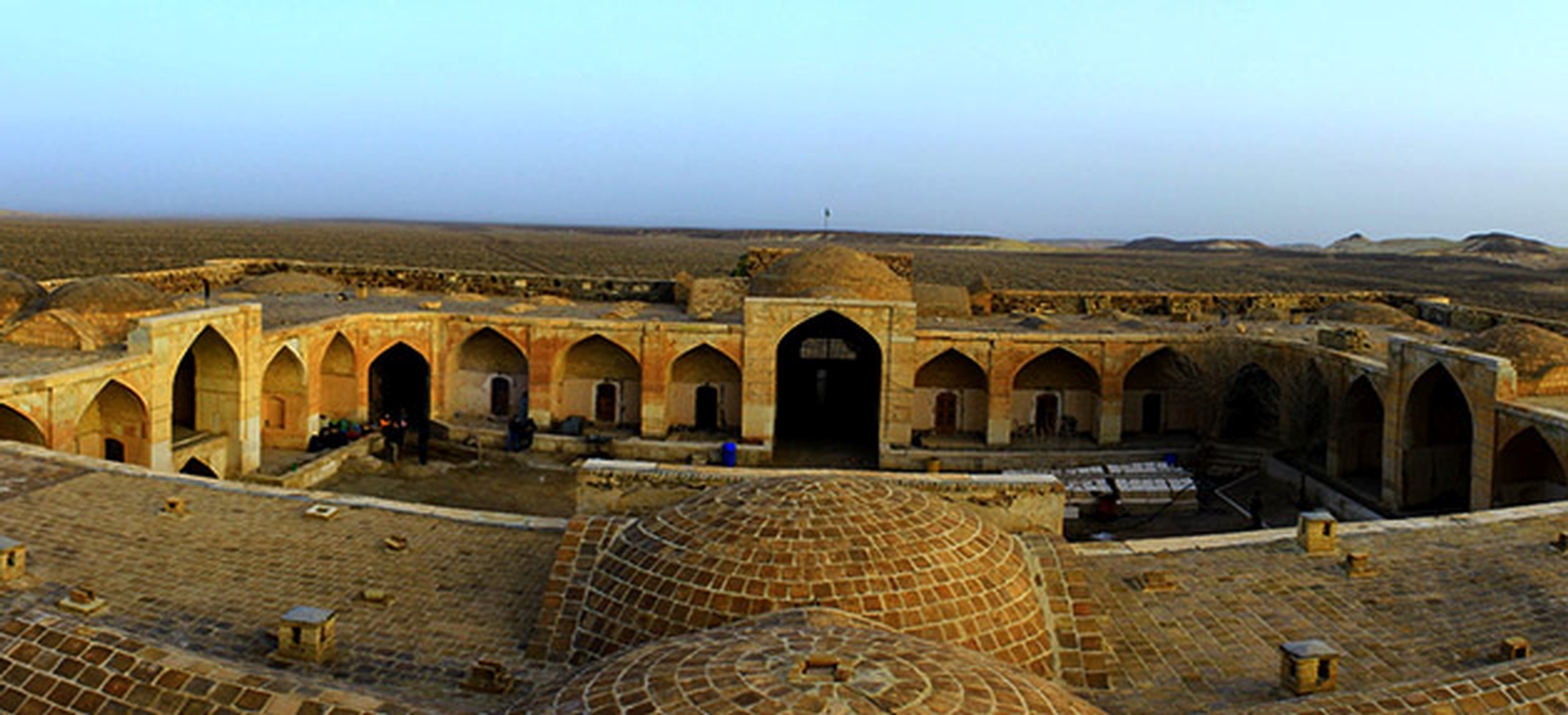
ЩҶЪ©ШӘЩҮвҖҢЫҢ Ш¬Ш§Щ„ШЁ ШўЩҶЪ©ЩҮ ШЁШұ ШұЩҲЫҢ ШіЩҶЪҜвҖҢЩҮШ§ЫҢ ШӘШұШ§Шҙ ЩҶЩ…Ш§ ЩҲ ШӘШ®ШӘЩҮвҖҢШіЩҶЪҜвҖҢЩҮШ§ЫҢ Ъ©Ш§ЩҶШ§Щ„ ШіЩҶЪҜЫҢШҢ ШӯШұЩҲЩҒ Щ„Ш§ШӘЫҢЩҶ Q, O, D, P, E, Y, W, M, S ШӯЪ© ШҙШҜЩҮ Ъ©ЩҮ ШёШ§ЩҮШұШ§ЩӢ
Ш№Щ„Ш§ШҰЩ… ШіЩҶЪҜвҖҢШӘШұШ§ШҙШ§ЩҶ ЩҮШіШӘЩҶШҜ. ШҙШ§ЫҢШҜ Ш§ШІ ШұЩҲЫҢ ШўЩҶЩҮШ§ ШЁШӘЩҲШ§ЩҶ ШЁЩҮ Ш§ЫҢЩҶ ЩҶШӘЫҢШ¬ЩҮ ШұШіЫҢШҜ Ъ©ЩҮ Ш§ШӯШӘЩ…Ш§Щ„Ш§ЩӢ ЩҫЫҢЩ…Ш§ЩҶЪ©Ш§Шұ ЫҢШ§ ШЁЩҶШ§ ЫҢЪ© ЩҒШұШҜ Ш®Ш§ШұШ¬ЫҢ ШЁЩҲШҜЩҮ Ш§ШіШӘ.
ШҜШұ ШіШ§Ш®ШӘ ШЁЩҶШ§ Ш§ШІ ШіЩҶЪҜвҖҢЩҮШ§ЫҢ ШұЩҲШҙЩҶ Ш§ШіШӘЩҒШ§ШҜЩҮ ШҙШҜЩҮ Ш§ШіШӘШӣ ШЁЩҶШ§ШЁШұШ§ЫҢЩҶ Щ…ЫҢвҖҢШӘЩҲШ§ЩҶ ШӘШөЩҲШұ Ъ©ШұШҜ ШІЩ…Ш§ЩҶЫҢ Ъ©ЩҮ Ъ©Ш§ШұЩҲШ§ЩҶШіШұШ§ ШІЩҶШҜЩҮ ШЁЩҲШҜЩҮШҢ ШҜШұ ШҜЩ„ Щ…ЩҶШ·ЩӮЩҮвҖҢШ§ЫҢ Ъ©ЩҮ ШіЩҶЪҜвҖҢ
Ъ©ЩҲЩҮвҖҢЩҮШ§ЫҢШҙ ЩҮЩ…ЩҮ ШіЫҢШ§ЩҮ ШЁЩҲШҜЩҮвҖҢШ§ЩҶШҜШҢ ЪҶЩҮ Ш¬Щ„ЩҲЩҮвҖҢШ§ЫҢ ШҜШ§ШҙШӘЩҮ Ш§ШіШӘ.
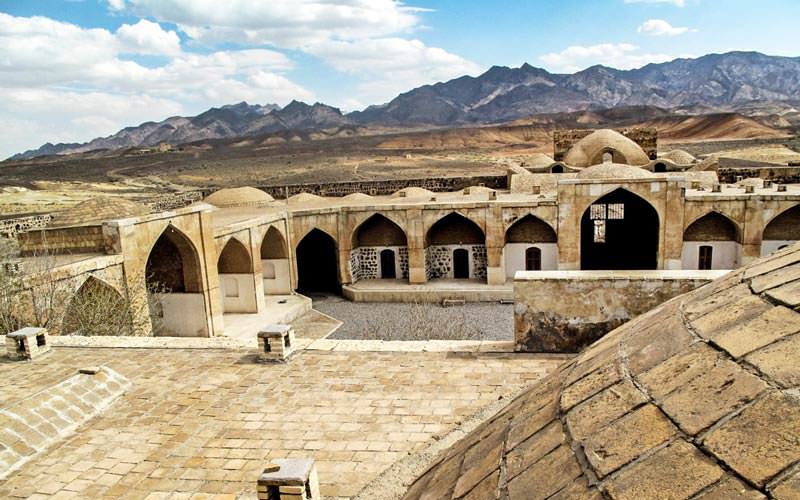
ЩҫЩ„Ш§ЩҶ ШЁЩҶШ§ Ш§ШІ ЩҶЩҲШ№ Щ…ШӘЩӮШ§ШұЩҶ ЩҲ Щ…ШұШЁШ№ Щ…ШіШӘШ·ЫҢЩ„ ШЁЩҮ Ш§ШЁШ№Ш§ШҜ Ы·Ыҙ ШҜШұ Ы¶Ыө Ш§ШіШӘ. ШҜЩҲ ШҜШұ ШҜШ§ШұШҜ: ЫҢЪ©ЫҢ Ш¬ЩҶЩҲШЁЫҢ ЩҲ ШҜЫҢЪҜШұЫҢ ШҙЩ…Ш§Щ„ЫҢ. ШҜЩҲ ШіЪ©ЩҲ ЩҲ ШҜЩҲ Ш§ШӘШ§ЩӮ ЩҮЩ… ШҜШұ ШҜЩҲ Ш·ШұЩҒ
ШҜШұЩҲШ§ШІЩҮвҖҢЫҢ ЩҲШұЩҲШҜЫҢ ЩҲШ¬ЩҲШҜ ШҜШ§ШұШҜ. ШҜШ§Ш®Щ„ ШўЩҶ ШӯЫҢШ§Ш· ШЁШІШұЪҜЫҢ Ш§ШіШӘ Ъ©ЩҮ ШҜЩҲШұШӘШ§ШҜЩҲШұ ШўЩҶ ШұШ§ Ш§ШӘШ§ЩӮвҖҢЩҮШ§ЫҢ Ъ©ЩҲЪҶЪ© ЩҒШұШ§ЪҜШұЩҒШӘЩҮ Ш§ШіШӘ. ШҜШұ ШЁШҜЩҶЩҮвҖҢЫҢ ШәШұШЁЫҢ ШӯЫҢШ§Ш· ЫҢЪ© ШӘШ§Щ„Ш§Шұ ШЁШ§
ШҙШ§ЩҮвҖҢЩҶШҙЫҢЩҶ ЩҲ Ш·Ш§ЩӮЪҶЩҮвҖҢЩҮШ§ЫҢЫҢ ШҜШұ Ш§Ш·ШұШ§ЩҒ ЩҲ Ш§ЫҢЩҲШ§ЩҶЫҢ ШҜШұ Ш¬Щ„ЩҲ ШіШ§Ш®ШӘЩҮ ШҙШҜЩҮ ЩҲ ШҜШұ ШІЫҢШұ ШӘШ§Щ„Ш§Шұ ШІЫҢШұШІЩ…ЫҢЩҶ ШЁШІШұЪҜЫҢ Ш§ШіШӘ. ШҜШұ ЩҫШҙШӘ ШіШ§Ш®ШӘЩ…Ш§ЩҶвҖҢЩҮШ§ЫҢ ШҜШ§Ш®Щ„ ШӯЫҢШ§Ш· ЩҮЩ…
Ш·ЩҲЫҢЩ„ЩҮвҖҢЩҮШ§ЫҢ ШіШұШ§ШіШұЫҢ ШЁШ§ ШўШ®ЩҲШұЩҮШ§ЫҢ Щ…ШӘШ№ШҜШҜ ЩҲ Ъ©ЩҶШ§Шұ ЩҮШұ ШўШ®ЩҲШұ ШіЪ©ЩҲЫҢЫҢ ШЁШұШ§ЫҢ Ш§ШіШӘШұШ§ШӯШӘ ЪҶЩҮШ§ШұЩҫШ§ШҜШ§Шұ ЩҲ Ш§Ш¬Ш§ЩӮЫҢ ШЁШұШ§ЫҢ Ш·ШЁШ® ШЁЩҲШҜЩҮ Ш§ШіШӘ. ШҜШұ ЪҶЩҮШ§Шұ ЪҜЩҲШҙЩҮ
ЩҲ Щ…ЫҢШ§ЩҶ Ш§Ш¶Щ„Ш§Ш№ ШҙШұЩӮЫҢ ЩҲ ШәШұШЁЫҢ ЩҶЫҢШІ ШҙШҙ ШЁШұШ¬ ШҜЩҒШ§Ш№ЫҢ Ъ©ЩҮ ШҜШ§ШұШ§ЫҢ ШӘЫҢШұЪ©Шҙ ЩҮШіШӘЩҶШҜ.
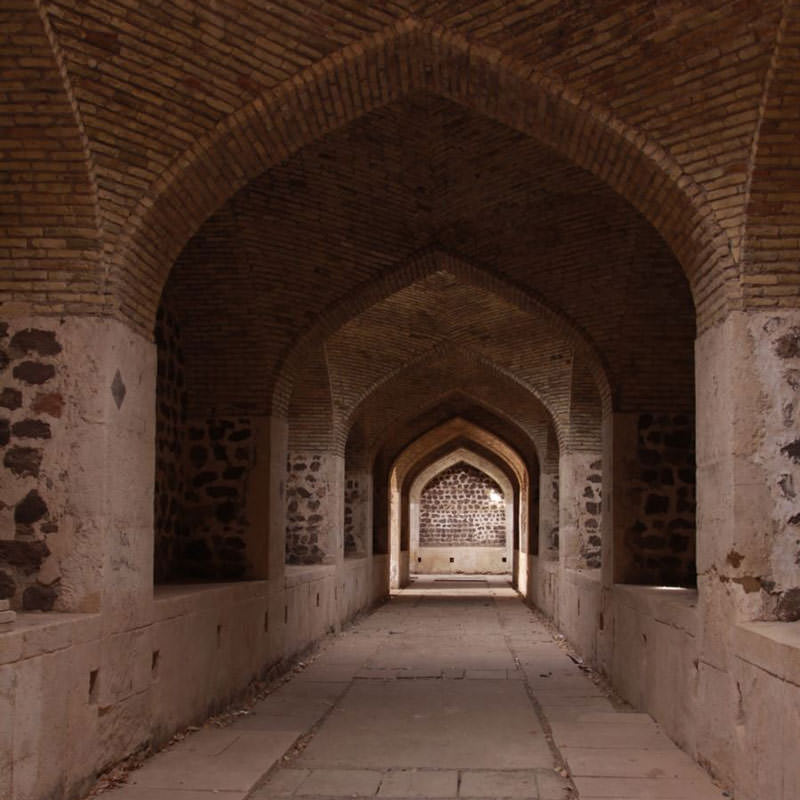
Ш§ЩҮЩ…ЫҢШӘ Ш¬ШәШұШ§ЩҒЫҢШ§ЫҢЫҢ Ъ©Ш§ШұЩҲШ§ЩҶШіШұШ§ ЩӮШөШұ ШЁЩҮШұШ§Щ…
Ш§ЪҜШұ ШЁЩҮ Щ…ЩҲЩӮШ№ЫҢШӘ Ш¬ШәШұШ§ЩҒЫҢШ§ЫҢЫҢ ЩҲ ШұШ§ЩҮвҖҢЩҮШ§ ЩҶЪҜШ§ЩҮ Ъ©ЩҶЫҢЩ… ШҜЩҲШұ ЩҶЩ…ЫҢвҖҢЩҶЩ…Ш§ЫҢШҜ Ъ©ЩҮ Ъ©Ш§ШұЩҲШ§ЩҶШіШұШ§ Ш¬Ш§ЫҢЪҜШ§ЩҮ Щ…ЩҮЩ…ЫҢ ШұШ§ Ш§ШӘШ®Ш§Ш° Ъ©ЩҶШҜ: Ъ©Ш§ШұЩҲШ§ЩҶШіШұШ§ ШҜШұ Щ…ШӯЩ„ЫҢ ЩҲШ§ЩӮШ№ ШҙШҜЩҮ Ъ©ЩҮ Ш§ШІ ШўЩҶ
ЫҢЪ© Щ…ШіЫҢШұ Ш§ШІ ШіЩ…ШӘ Ъ©ЩҲЫҢШұ ШЁЩҮ the Garmsar district ЩҲ ЩҒЫҢШұЩҲШІЪ©ЩҲЩҮ Щ…ЫҢвҖҢШұЩҒШӘ ЩҲ Ш§ШІ ЫҢЪ© Щ…ШіЫҢШұ ШЁЩҮ ЩҲШұШ§Щ…ЫҢЩҶ ЩҲ ШӘЩҮШұШ§ЩҶ. ШҜШұ ЩҲШ§ЩӮШ№ ЩӮШЁЩ„ Ш§ШІ Ш§ЫҢЩҶЪ©ЩҮ Ш¬Ш§ШҜЩҮвҖҢЫҢ ШӘЩҮШұШ§ЩҶ-ЩӮЩ… ШұШ§ЩҮвҖҢШ§ЩҶШҜШ§ШІЫҢ
ШҙЩҲШҜШҢ Ш§ЫҢЩҶ Щ…ШіЫҢШұ Ъ©ЩҲШӘШ§ЩҮвҖҢШӘШұЫҢЩҶ ШұШ§ЩҮ ШЁЫҢЩҶ ШӘЩҮШұШ§ЩҶ ЩҲ Ъ©Ш§ШҙШ§ЩҶ ШЁЩҲШҜ ЩҲ ШӯЪ©Щ… ШҙШ§ЩҮШұШ§ЩҮ ШұШ§ ШҜШ§ШҙШӘ.
ЩҮЩ…Ш§ЩҶвҖҢШ·ЩҲШұ Ъ©ЩҮ Ш§ШҙШ§ШұЩҮ ШҙШҜШҢ ШҜШұ ШҜЩҲШұЩҮвҖҢЩҮШ§ЫҢ ШІЩ…Ш§ЩҶЫҢ Щ…Ш®ШӘЩ„ЩҒ Ш§ШҙШ§ШұШ§ШӘЫҢ Ш§ШІ Ъ©Ш§ШұЩҲШ§ЩҶШіШұШ§ ЩҲ ШұШ§ЩҮЫҢ Ъ©ЩҮ ШҜШұ ШўЩҶ ЩӮШұШ§Шұ ШҜШ§ШұШҜ ШҜШұ ШҜШіШӘ Ш§ШіШӘ. ШўЩҶЪҶЩҮ Щ…ШіЩ„Щ… Ш§ШіШӘ
ШўЩҶ Ш§ШіШӘ Ъ©ЩҮ Ш§ШІ ШҜЩҲШұЩҮвҖҢЫҢ ЩҫЩҮЩ„ЩҲЫҢШҢ ЩҲ ШҙШ§ЫҢШҜ ЩӮШҜШұЫҢ ЩӮШЁЩ„ Ш§ШІ ШўЩҶШҢ Ш§ЫҢЩҶ Щ…ШіЫҢШұ ЩҲ Ъ©Ш§ШұЩҲШ§ЩҶШіШұШ§ Ш§ШІ ШұЩҲЩҶЩӮ Ш§ЩҒШӘШ§ШҜ. Ш§ЫҢШұШ¬ Ш§ЩҒШҙШ§Шұ ШҜШұ ШіШ§Щ„ ЫіЫ· Щ…ЫҢвҖҢЩҶЩҲЫҢШіШҜ Ъ©Ш§ШұЩҲШ§ЩҶШіШұШ§
ЪҶЩҮЩ„вҖҢШіШ§Щ„ЫҢ Ш§ШіШӘ Ъ©ЩҮ Щ…ШӘШұЩҲЪ© ШҙШҜЩҮ ЩҲ ЪҜШ§ШЁШұЫҢЩ„ ЩҶЫҢШІ ШҜШұ ЪҜШІШ§ШұШҙШҙ Ъ©ЩҮ ШҜШұ ШіШ§Щ„ ЫұЫіЫұЫІ ЩҶЩҲШҙШӘЩҮ Щ…ЫҢвҖҢЪҜЩҲЫҢШҜ ШІЩ…Ш§ЩҶЫҢ Ъ©ЩҮ Ш§ЩҲ Ш§ШІ Ш¬Ш§ШҜЩҮ Щ…ЫҢвҖҢЪҜШ°ШҙШӘЩҮШҢ Ш§ШІ
Ъ©Ш§ШұЩҲШ§ЩҶШіШұШ§ Ш§ШіШӘЩҒШ§ШҜЩҮвҖҢШ§ЫҢ ЩҶЩ…ЫҢвҖҢШҙШҜЩҮ Ш§ШіШӘ.
Ш§ЫҢЩҶ ШіШ§Ш®ШӘЩ…Ш§ЩҶ Ш§Ъ©ЩҶЩҲЩҶ ШЁЩҮ Ш№ЩҶЩҲШ§ЩҶ Щ…ЩҮЩ…Ш§ЩҶвҖҢШіШұШ§ЫҢ ЩҫШ§ШіЪҜШ§ЩҮ ШҙЪ©Ш§ШұШЁШ§ЩҶЫҢ ШҜШұ ЩҫШ§ШұЪ© Щ…Щ„ЫҢ Ъ©ЩҲЫҢШұ Щ…ЩҲШұШҜ ШЁЩҮШұЩҮвҖҢШЁШұШҜШ§ШұЫҢ ЩӮШұШ§Шұ Щ…ЫҢвҖҢЪҜЫҢШұШҜ.
ШұШ§ЩҮ Ш§ШөЩ„ЫҢ ШЁЩҮ Щ…ЩҶШ·ЩӮЩҮвҖҢЫҢ ЩҫШ§ШұЪ© Щ…Щ„ЫҢ Ъ©ЩҲЫҢШұ Ш§ШІ ШӘЩҮШұШ§ЩҶ Ш§ШІ Ш·ШұЫҢЩӮ Ш¬Ш§ШҜЩҮвҖҢЫҢ ШўШіЩҒШ§Щ„ШӘЩҮвҖҢЫҢ ЩҲШұШ§Щ…ЫҢЩҶ-ЩҫЫҢШҙЩҲШ§ (Ш§Щ…Ш§Щ…ШІШ§ШҜЩҮ Ш¬Ш№ЩҒШұ) Ш§ШіШӘ. Ш¬Ш§ШҜЩҮвҖҢЫҢ ШҙЩҲШіЩҮвҖҢЫҢ Ъ©ЩҶШ§Шұ
ШұШ§ЩҮвҖҢШўЩҮЩҶ ШЁЩҮ Щ…ШЁШ§ШұЪ©ЫҢЩҮ Щ…ЫҢвҖҢШұШіШҜ. Ш¬Ш§ШҜЩҮ Ш§ШІ ШӯШ§ШҙЫҢЩҮвҖҢЫҢ Щ…ЩҶШ·ЩӮЩҮвҖҢЫҢ Щ…ШЁШ§ШұЪ©ЫҢЩҮ Ш§ШҜШ§Щ…ЩҮ ЩҫЫҢШҜШ§ Щ…ЫҢвҖҢЪ©ЩҶШҜ ЩҲ ШЁШ№ШҜ Ш§ШІ ШўЩҶ ЩҲШ§ШұШҜ Щ…ЩҶШ·ЩӮЩҮ Щ…ЫҢвҖҢШҙЩҲШҜ.
Ш§ШІ Ъ©Ш§ШҙШ§ЩҶ ЩҮЩ… ШЁШ§ЫҢШҜ ШЁЩҮ ШўШұШ§ЩҶ ЩҲ ШЁЫҢШҜЪҜЩ„ ШұЩҒШӘ ЩҲ Ш§ШІ ШўЩҶШ¬Ш§ ШЁЩҮ Щ…ШұЩҶШ¬Ш§ШЁ. ШіЩҫШі Ш§ШІ ШұШ§ЩҮ Ъ©ЩҲЫҢШұ Ъ©ЩҮЪ© ШҙЩҮШұШіШӘШ§ЩҶ ЪҜШұЩ…ШіШ§Шұ ЩҮЩ… Щ…ЫҢвҖҢШҙЩҲШҜ ЩҲШ§ШұШҜ ЩҫШ§ШұЪ© Щ…Щ„ЫҢ Ъ©ЩҲЫҢШұ ШҙШҜ.
Ъ©Ш§ШұЩҲШ§ЩҶШіШұШ§ЫҢ ЩӮШөШұ ШЁЩҮШұШ§Щ… ШҜШұ ЫұЫі Ш§ШұШҜЫҢШЁЩҮШҙШӘ ЫұЫіЫөЫҙ ШЁШ§ ШҙЩ…Ш§ШұЩҮ ЫұЫ°ЫөЫҙ ШЁЩҮ Ш¬Щ…Ш№ ШўШ«Ш§Шұ Щ…Щ„ЫҢ ЩҫЫҢЩҲШіШӘ ЩҲ ШЁЩҮШӘШұЫҢЩҶ ЩҶЩӮШ·ЩҮ ШҜШұ ЩҫШ§ШұЪ© Щ…Щ„ЫҢ Ъ©ЩҲЫҢШұ Ш§ШІ Щ…ЩҶШёШұ ЪҜШіШӘШұШҙ
Ш§Ъ©ЩҲШӘЩҲШұЫҢШіЩ…В ШҙЩҶШ§Ш®ШӘЩҮ ШҙШҜЩҮ Ш§ШіШӘ.
